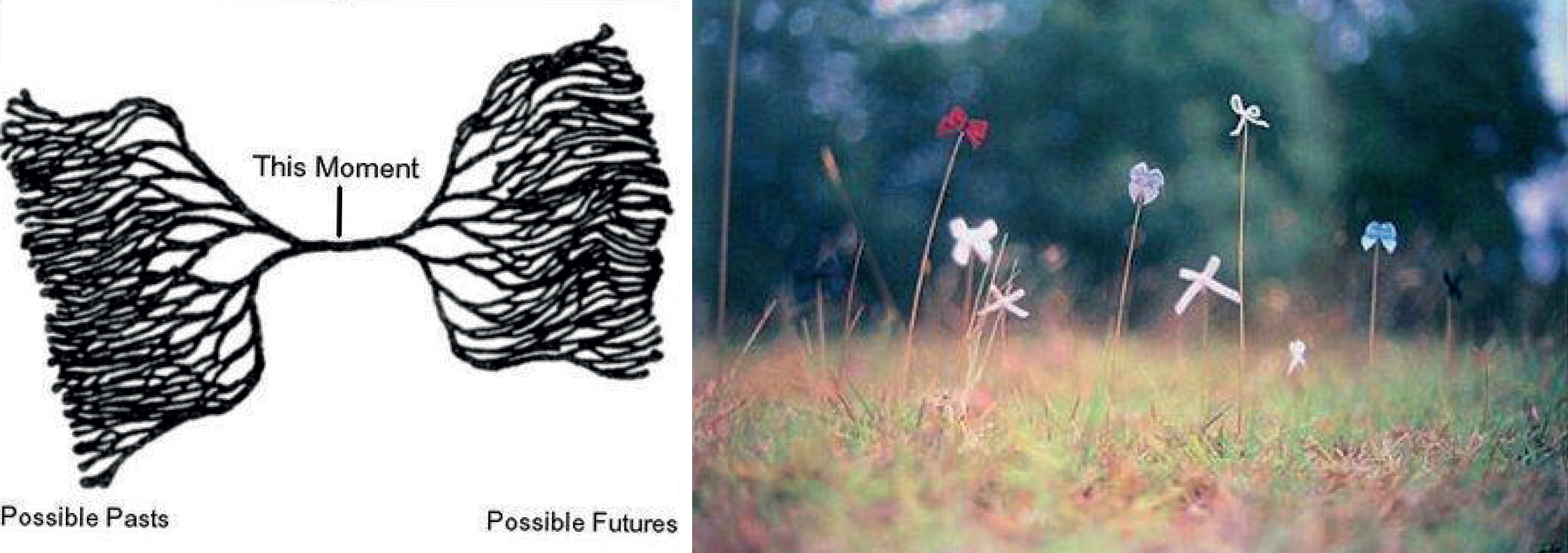“Life + art is a boisterous communion/communication with the dead. It is a boxing match with time”
—Jeanette Winterson,Why Be Happy When You Can Be Normal?

—Matt Johnson, “The Shape of Time,” 2009.
What does time look like? I think of two hammocks, one an individual human can feel on the body, and one vast….Universe as hammock? The holding and the mesh and mold ability seem key.
—Alice Lesnick, E-mail
Consider, for a moment (what is a moment?), these three images—one visual, two verbal—each replacing the inexorable “train track” of linear time, and its anxious measurement in school settings, with the possibility of communicating with the past (and future?). Visualize, for a moment (what is a moment?), the enabling vision of a “loopy” universe. Or of one molded to us and holding us up. Or—even better—moldable by us to (better) sustain us all. Re-visualize, for a moment (what is a moment?), the time in which we are teaching and learning, not only as sequential but also as iterative, not only as measured but also as experienced, not only as outer but also as inner. Imagine, for a moment (what is that moment?), a form of education that is less driven by the clock, less bound by the conventional rituals of school time.Cf. Joseph Cambone, “Time for Teachers in School Restructuring,” Teachers College Record 96, no. 3 (Spring 1995): 517.
“Timing clearly enters into the measurement of educational achievement…through the numerous forms of timed testing in which performance is evaluated in relation to material grasped in a specific segment of time….the quality of reflection is conditioned by its temporal organization, and so, too, is the quality of imagination”
—Hope Jensen Leichter, “A Note on Time and Education”
A review of the past several decades of publications in Teachers’ College Record turns up very few articles that acknowledge, as Hope Leichter did in 1980, the way in which “all educational experience…is organized in time.” Leichter’s observations, that the “assumptions about time and timing” that “pervade educational theory and practice” “often remain unexamined,” and “alternative modes of temporal organization ignored,”Hope Jensen Leichter, “A Note on Time and Education,” Teachers College Record 81, no. 3 (Spring 1980): 360 remain as true now as they were when she conducted her study over thirty years ago.
The adoption of business values and practices in educational administration has been extensively documented in Raymond Callahan’s classic study of Education and the Cult of Efficiency, which denounces the latter as an “inadequate and inappropriate basis for establishing sound educational policy,”Raymond Callahan, Education and the Cult of Efficiency: A Study of the Social Forces that Have Shaped the Administration of the Public Schools (Chicago: The University of Chicago Press, 1962), viii and accordingly recommends changing the nature of graduate work in educational administration. Our own very compatible intervention involves re-thinking the role of standard “time” in education writ large.
U.S. educators long ago turned to factories as a model for designing schools;Jeannie Oakes and Martin Lipton, “Schooling: Wrestling with History and Tradition,” Teaching to Change the World, second edition (New York: McGraw-Hill Higher Education, 2006), 6, 22. the newly technologized, standardized, and purportedly “objective” testing regime has more recently given rise to subject-specific chunks of time, administered to students in age- and ability-specific groupings.Oakes and Lipton, “Schooling”; Diane Ravitch, The Death and Life of the Great American School System: How Testing and Choice are Undermining Education (New York: Basic Books, 2010. In now bringing this particular—and profoundly disabling—dimension of educational practice into focus, we challenge the belief that the purpose of education is to turn out children at a standard pace, with a measurable set of skills. Current education policies such as No Child Left Behind and Race to the Top demonstrate the persistence and intensification of narrowly quantifiable learning and measurable results. These days, the only learning that counts is countable. The drumbeat of “time on task” and measurable achievement locks students into a system in which one very particular kind of productivity is maximized.Jean Anyon, “Social Class and the Hidden Curriculum of Work,” Journal of Education 162, no. 1 (Fall 1980). These procedures are of course not limited to K-12 institutions. Ellen Samuels explains, for instance, that graduate student education at the University of California at Berkeley “is structured by an administrative construct called, with no hint of irony, ‘normative time,’ referring ‘to the amount of time it takes ideally for a student in a particular discipline to complete a doctoral degree.’”Ellen Samuels, “Cripping Anti-Futurity, or, If You Love Queer Theory So Much, Why Don’t You Marry It?” (paper presented at the Society for Disability Studies Conference, San Jose, California, 2011. Alison Kafer has also more recently challenged the normative and normalizing expectations of pace and schedule by evoking a “resistant orientation” to “productivity, accomplishment, efficiency.”Alison Kafer, Feminist, Queer, Crip (Bloomington: Indiana University Press, 2013), 40.
We join Samuels and Kafer in our argument that the heavy drivers of time and a narrowly productive status quo fail to match the complex world we learn and live in.
In 1931
—eighty-one years ago—
Salvador Dalí etched his final strokes on La persistència de la memòria…
And so we recommend some alterations in educational practice—as well as in discursive form (you’ll begin to notice now a few of our poetic experiments, interspersed in this text, in slightly smaller font, in hopes of interrupting the “flow” of things….)
“What would academia look like if we built in more interstices, more time when ‘nothing’ happened?”
—Margaret Price, “Ways to Move”
“…the aim is to slow down…truly theoretical reflection is possible only if thinking decelerates…finding anomalies, paradoxes, and conundrums in an otherwise smooth-looking stream of ideas”
—Timothy Morton, Ecology Without Nature
“Slowing down,” learning to teach and learn in what Thomas Berry calls more “comprehensive dimensions of space and time,” Thomas Berry, “A New Story,” The Dream of the Earth (San Francisco: Sierra Club Books, 1988), 123-37.
…the three withering clocks were thought
are thought
to be a symbol of the unconscious, its violent collapse between
time
and
space…
we here interrogate the “time-bound”: our academic attachment to conventional understandings and measurements of time, and of its concomitant anxieties. In educational practice, suspending modern temporality
…the arrows begin to waver;
7:55 grows
annular…
means questioning our attachment to the clearly demarcated limits of conventional, linear time, which moves only—and quickly!—in one direction, in order to be measured, and to enable us to measure ourselves against one another.
no longer fixed and pointed,
but adaptable,
molten…
Our work with Bryn Mawr’s Active Minds has made it clear to us that such time-based measures of achievement are problematic, as is our attachment to an understanding of time that undergirds such measurements.
…saturated within this liquifying temporality
the Coast of Catalgonia
droops…
We need a more relaxed, hammock-like way of thinking about what happens in educational practice, one in which the shared time we occupy in classrooms gives “space” to a more capacious sense of phenomenological time, one in which past, present and future are intertwined.
Joseph Cambone, one of the few educational researchers who has written about the effect of time in school reform, observes that “time is largely a collective subjectivity—an agreed-upon convention that allows us to structure our lives temporally.” We need to place ourselves in the same place at the same time; we need to be “on time” so we can be together “in time.” Given the extent of such arrangements, “to restructure people’s time,” as Cambone acknowledges, “is actually to restructure their thinking and being.”Cambone, “Time for Teachers,” 513–14.
Re-structuring our shared subjectivity in this way would involve “re-doing” our conception of time in ways that acknowledge what we all know, but continually forget: that the most profound experiences of our educational lives happen “outside” measured time, moving freely across the dimensions we conventionally distinguish as “past” and “future.”
…the horizon caves in and our sense of futurity softens to a miry
evanesce &
Reading texts written hundreds of years ago, or speculating about future possibilities, we continually cross the borders of the conventional rituals of school time, those “strong boundaries” of the socio-temporal that demarcate “the beginning and endings of periods, school days, and school years.”Cambone, “Time for Teachers,” 517.
…time, like the melting Camembert cheese that inspired Dalí’s art, becomes
Cambone asserts that such boundaries “cannot be transgressed without incident.”Cambone, “Time for Teachers,” 517. It is our counter-assertion that the most profound academic work is actually constituted by such transgressions, emerging through temporal leaps, beyond standards, beyond measured expectations.
“The point is to go against the grain of dominant, normative ideas….the only ethical option…is critical and self-critical….the guiding slogan is: ‘not afraid of nonidentity’”
—Timothy Morton, Ecology Without Nature
“So I read on. And I read on, past my own geography and history, past the founding stories….The great writers were not remote….Time is not constant and one minute is not the same length as another”
—Jeanette Winterson, Why Be Happy When You Can Be Normal?
Many disability studies scholars include time in their systematic “cripping” of normative assumptions about human experience. “Crip time” has several different meanings: the term has been used to describe “pre-programmed” time, the sort of scheduling that seems entirely overwritten “with other people’s voices.”Anne McDonald, “Crip Time.” It has also been used, contrariwise, and much more extensively, to signal interventions into such programming: accommodations, “a flexible standard for punctuality,” the need for “extra time”“Crip Time,” Dictionary of American Slang.—although negotiating such accommodations is always “tricky against the normative ebbs and flows of legitimated knowledge production.”Borderdwelling, “The Ph.D. and Normative Time,” Brooke’s Blog, July 4, 2012.
The concept of “crip time” could also conceivably be used in a third sense, to identify the possibility—the profound need—for some time that (as an anonymous reviewer of this essay observed) is “just plain wasted…sometime we are just ‘doing time’—in depression, in illness, in times when there is nothing really beyond surviving to do.” Although the field of disability studies has evoked, and advocated for, the variability of “crip time,” it has not wrestled directly (so far as we know) with this notion of wasting time. Like the women’s movement, and the women’s colleges like Bryn Mawr that emerged from it, the disability movement seems particularly, and somewhat paradoxically, invested in a narrative of “overcoming” particular impairments, in order to be taken seriously in the academy. The field hasn’t yet offered us, we think, the tools we need to interrupt the narrative of academic achievement, to find a space where nothing happens, to discover gaps in which normative time is ruptured, suspended.
And so we gesture, here, toward some of those possibilities that lie in empty and “unproductive” time.
…do the gossamer clocks meld or resist?
protest
or conform?…
”Does the demonstration of coherence indicate a stronger mind?”
—Margaret Price, Mad at School
Does getting your work in on time indicate a stronger mind? (Or: why is punctuality so important?)
Margaret Price has conducted an extensive analysis of the ways in which the academy’s structuring of itself around schedules—placing importance on appointments, deadlines, the completion of timed tasks—excludes and discriminates against those with mental disabilities; she shows how the demands of academia can exacerbate symptoms which may be manageable in a less stressful environment. It is relatively easy for a college to imagine accommodating physical disabilities, Price argues, but much harder for a place that prides itself on mental accomplishment to envision accommodating mental diversity and difference—to adjust, in particular, to the altered pacing that differently minded minds might require.Price, Mad at School, 25–57.
As an alternative to current time-based arrangements, Halberstam advocates other temporal models. Her concept of “queer time”—the outcome of “imaginative life schedules, and eccentric economic practices,” of “non-normative logics and organizations” of activity—invites us to imagine “other logics of location, movement, and identification,” to mark out “willfully eccentric modes of being.”Halberstam, Queer Time, 1, 6; cf. Samuels, “Cripping.”
…do we construe, from this canvas, a disorientation or a consoled contentment?
…is it a mercurial shifting that whittles this indefinite journey?…
Our own interrogating—querying, queering, cripping, maddening—of educational time accepts Halberstam’s bid to re-conceptualize what time looks-and-feels like. Of particular use in our attempts to make the academy more welcoming of difference, and more able to acknowledge multiple modes of failure and achievement, is Halberstam’s proposition that we step out of “the logic of capital accumulation,” to live and work “on the edges of logics of…production.”Halberstam, Queer Time, 7, 10.
In 1873, Edward Clarke was concerned that the education of young women would inhibit and threaten the health of generations to come.
…is what is lost in time gained in
an intransigent
standstill?…
In this decade, Halberstam is inviting another generation of young women to break away from “repro-time,” to embrace alternative logics that don’t simply reproduce what has been done before. She thus addresses the two-fold fears of Edward Clarke, that educated women might fail to bear both biological and intellectual fruit. In imagining an education system that does not reproduce old-fashioned understandings of time, and thereby reproduce old divisions among various kinds of “mindedness,” we also attempt to correct both of Clarke’s “mis-conceptions.”
…angular rocks give way to curved conditionings…
We imagine a form of schooled time marked less by tests needing to be passed “in time” and “on time” than by an understanding that we are all “held up by” a hammock-like, loopy, iterative structure.
Can we imagine a college semester that isn’t organized according to conventional temporal logics?
Can we imagine academic time that isn’t organized by semesters?
Schooling restructured in such time might involve a “spiral curriculum,” fostering re-examination of a subject “in different forms at different stages”Leichter, “A Note on Time,” 368. Or perhaps, following GrayandGrey, it will evoke “some other shapes”:GrayandGrey, “Some Other Shapes,” March 27, 2009.

In sharp contrast to Edward Clarke’s characterization of the “closed bodily systems” of nineteenth-century women, which contained “only finite amounts of energy,” we’ve been experimenting here with very different representations: of the fluid “self” of the contemporary woman, of her relationship to others in an academic environment, and of the various forms her prose—our prose—might take. We have been trying out what might emerge if we break through the barriers crucial to keeping a system “closed.”
…drip drop,
tick tock…
We have played here with the possibilities opened up by “maddening,” or “montaging,” academic writing, interrupting the conventional, sequential form of argumentation with images, snips of poetry, and quotations, not woven seamlessly into the whole, but rather creating “holes” within it.
Being “transminded,” to our minds, not only refuses the binary of mental health and illness, acknowledging the mutability of a spectrum of identities, the shifting “self,”
…a dissolving persistency
a phase ensconced in and contradiction..
but also invites different forms of “composition” than the conventional representations of “coherence.”Cf. McRuer, Crip Theory; Price, Mad at School.
“I live life in slow motion. The world I live in is one where my thoughts are as quick as anyone’s, my movements are weak and erratic, and my talk is slower than a snail in quicksand…. I communicate at the rate of 450 words an hour compared to your 150 words in a minute—twenty times as slow. A slow world would be my heaven. I am forced to live in your world, a fast hard one…. I need to speed up, or you need to slow down.”
—Anne McDonald, “Crip Time”
We have moved from a fictional story about a young woman, maddened over 100 years ago by her efforts to complete her studies at Bryn Mawr, to an alternative tale that re-positions our apprehensions about productivity and achievement within larger temporal arrangements. Edward Clarke was concerned both that women’s intellectual work would be insufficient, and that it would interrupt their ability to reproduce. In the founding of Bryn Mawr, M. Carey Thomas and her cohorts countered that anxious narrative. Now, in a time when it is still a challenge for women to have children and academic careers, we again attempt to re-write that story, querying the disabling effect of temporal demands, in search of a quirkier temporality in which we might all flourish. This more pliant time might include a range of unexpectedly “stretchy” forms: surely more lenient deadlines, but perhaps also more defined structures, for flexible minds that need tighter bounds. For some of us, more open, exploratory configurations would provide finer spaces for flourishing; for others, clearer access to what is needed, and more transparency about expectations, might provide the necessary “mesh,” a much-needed “hammock.”
Setting “madness” in motion has meant our moving words and images around on the page, in demonstration of an open, and “open-minded,” system. Beyond this essay,
…dream in undefinable moments,
inclusive instants,
slivered seconds…
time as a hammock, inherently stretch-y like the “transmind,” offers us dilation, heterogeneity, resistance to rhetoric. “Achievement,” in a world so conceived, needn’t imply completion; it might instead gesture, as we do here, towards what is incomplete, even uncomplete-able…
